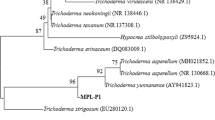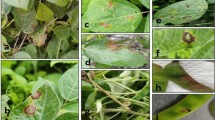Abstract
The present study was carried out to evaluate the antagonistic efficacy of Aspergillus versicolor against the soil and seed inhibiting destructive plant pathogen Macrophomina phaseolina. The tested antagonist was confirmed by rDNA sequencing of ITS and β-tubulin genes with respective accession numbers MN719083 and MN736397. In dual culture bioassays, A. versicolor showed potent antagonist activity and reduced the pathogen’s growth by 60% over control. To understand the mechanism of antagonistic fungus, DNA of the pathogenic fungus was incubated in secondary metabolites produced by the A. versicolor for 24 and 48 h. After 48 h, metabolites of A. versicolor fully degraded the DNA of M. phaseolina. Moreover, for the identification of bioactive compounds, the chloroform and ethyl acetate fractions of A. versicolor culture filtrates were subjected to GC–MS analysis. A total of 10 compounds were identified in each of the two fractions. Among these, chondrillasterol (37.43%) followed by 1,2-benzedicarboxylic acid, diisooctyl ester (25.93%), decane (16.63%), 9,12-octadecadienoic acid (Z,Z)- (13.32%), stigmasterol (11.16%), undecane (10.93%), cis-1-chloro-9-octadecene (8.66%), benzene, 1,3,5-trimethyl (8.46%), and hexadecanoic acid, 2-hydroxy-1-(hydroxymethyl) ethyl ester (8.13%) were the major compounds. Some of the identified compounds are known to possess strong antifungal, antibacterial, nematicidal, and antioxidant properties. The present study concludes that A. versicolor is an effective antagonist against M. phaseolina.


© program. The phylogenetic tree was constructed using the neighbor-joining method in MEGA x version 10.1




Similar content being viewed by others
Data availability
All relevant data may be made freely available to readers.
Code availability
Not applicable.
References
Ouoba A, Sawadogo N, Ouedraogo MH, N, kangre H, Ngolo M, Konate EP, et al (2019) Phenotyping bambara groundnut landraces for resistance to Macrophomina phaseolina (Tassi) Goidnich. Int J Agric Biol 21:547–552. https://www.researchgate.net/publication/330562995
Mazzola M, Agostini A, Cohen MF (2017) Incorporation of brassica seed meal soil amendment and wheat cultivation for control of Macrophomina phaseolina in strawberry. Eur J Plant Pathol 149:57–71. https://doi.org/10.1007/s10658-017-1166-0
Bakr RA, Hamad AS (2019) Survey varietal reaction and chemical control of strawberry charcoal rot in Egypt. Pak J Phytopathol 31:55–66. https://doi.org/10.33866/phytopathol.031.01.0500
Li D, Suh S (2019) Health risks of chemicals in consumer products: a review. Environ Int 123:580–587. https://doi.org/10.1016/j.envint.2018.12.033
Akhtar R, Javaid A (2018) Biological management of basal rot of onion by Trichoderma harzianum and Withania somnifera. Planta Danin 36:e017170507. https://doi.org/10.1590/s0100-83582018360100009
Keeffe E, Hughes H, McLoughlin P, Tan SP, Mcarthy N (2019) Methods of analysis for the in vitro and in vivo determination of the fungicidal activity of seaweeds: a mini review. J Appl Phycol 32:1–18. https://doi.org/10.1007/s10811-019-01832-7
Sridharan AP, Sugitha T, Karthikeyan G, Nakkeeran S, Sivakumar U (2021) Metabolites of Trichoderma longibrachiatum EF5 inhibits soil borne pathogen Macrophomina phaseolina by triggering amino sugar metabolism. Microb Pathog 150:104714. https://doi.org/10.1016/j.micpath.2020.104714
Ting ASY, Jioe E (2016) In vitro assessment of antifungal activities of antagonistic fungi towards pathogenic Ganoderma boninense under metal stress. Biol Control 96:57–63. https://doi.org/10.1016/j.biocontrol.2016.02.002
Tiwari V, Singh R, Pandey AK (2017) Efficacy of some antagonistic fungi and botanicals against Fusarium solani causing damping-off disease in eggplant (Solanum melongena L). J Appl Biosci 43:47–56. https://www.researchgate.net/profile/Ak-Pandey/publication/326736022
Khan IH, Javaid A (2022) DNA cleavage of the fungal pathogen and production of antifungal compounds are the possible mechanisms of action of biocontrol agent Penicillium italicum against Macrophomina phaseolina. Mycologia 114(1):24–34. https://doi.org/10.1080/00275514.2021.1990627
Rizvi R, Mahmood I, Ansari S (2018) Interaction between plant symbionts, bio-organic waste and antagonistic fungi in the management of Meloidogyne incognita infecting chickpea. J Saudi Soci Agric Sci 17:424–434. https://doi.org/10.1016/j.jssas.2016.10.002
El-Debaiky SA (2017) Antagonistic studies and hyphal interactions of the new antagonist Aspergillus piperis against some phytopathogenic fungi in vitro in comparison with Trichoderma harzianum. Microb Pathog 113:135–143. https://doi.org/10.1016/j.micpath.2017.10.041
Jayaprakashvel M, Chitra C, Mathivanan N (2019) Metabolites of plant growth-promoting rhizobacteria for the management of soilborne pathogenic fungi in crops Secondary Metabolites of Plant Growth Promoting Rhizomicroorganisms Springer pp 293–315. https://link.springer.com/chapter/https://doi.org/10.1007/978-981-13-5862-3_15
Chigozie VU, Okezie MU, Ajaegbu EE, Okoye FB, Esimone CO (2022) Bioactivities and HPLC analysis of secondary metabolites of a morphologically identified endophytic Aspergillus fungus isolated from Mangifera indica. Nat Prod Res. https://doi.org/10.1080/14786419.2021.2021517
Sun Y, Liu J, Li L, Gong C, Wang S, Yang F et al (2018) New butenolide derivatives from the marine sponge-derived fungus Aspergillus terreus. Bioorg Med Chem Lett 28:315–318. https://doi.org/10.1016/j.bmcl.2017.12.049
Wu CJ, Cui X, Xiong B, Yang MS, Zhang YX, Liu XM (2019) Terretonin D1, a new meroterpenoid from marine-derived Aspergillus terreus ML-44. Nat Prod Res 33:2262–2265. https://doi.org/10.1080/14786419.2018.1493583
Ding L, Xu P, Li T, Liao X, He S, Xu S (2019) Asperfurandiones A and B, two antifungal furandione analogs from a marine-derived fungus Aspergillus versicolor. Nat Prod Res 33:3404–3408. https://doi.org/10.1080/14786419.2018.1480622
Landum MC, do Rosario FM, Alho J, Garcia R, Cabrita MJ, Rei F et al (2016) Antagonistic activity of fungi of Olea europaea L. against Colletotrichum acutatum. Microb Res 183:100–108. https://doi.org/10.1016/j.micres.2015.12.001
Shemshura ON, Bekmakhanova NE, Mazunina MN, Meyer SL, Rice CP, Masler EP (2016) Isolation and identification of nematode-antagonistic compounds from the fungus Aspergillus candidus. FEMS Microbiol Lett 363:1–9. https://doi.org/10.1093/femsle/fnw026
Khan IH, Javaid A (2021) In vitro screening of Aspergillus spp. for their biocontrol potential against Macrophomina phaseolina. J Plant Pathol 103(4):1195–1205. https://doi.org/10.1007/s42161-021-00865-7
Nakayama T (2017) Biocontrol of powdery scab of potato by seed tuber application of an antagonistic fungus Aspergillus versicolor isolated from potato roots. J Gen Plant Pathol 83:253–263. https://doi.org/10.1007/s10327-017-0716-9
Doyle JJ, Doyle JL (1990) Isolation of plant DNA from fresh tissue. https://scholar.google.com.pk/scholar Focus 12:39–40
Rini CR, Sulochana KK (2008) Usefulness of Trichoderma and Pseudomonas against Rhizoctonia solani and Fusarium oxysporum infecting tomato. J Trop Agric 45:21–28. http://jtropag.kau.in/index.php/ojs2/article/view/168
Khan IH, Javaid A (2020) Comparative antifungal potential of stem extracts of four quinoa varieties against Macrophomina phaseolina. Int J Agric Biol 24:441–446. http://www.fspublishers.org/published_papers/870_doi%2015.1457%20IJAB-20-0211%20(6).pdf
Hosen MD, Shamsi S (2019) In vitro antagonism of Trichoderma viride and Aspergillus spp. against a pathogenic seed borne fungus of sesame. J Bangladesh Acad Sci 43:17–23. https://doi.org/10.3329/jbas.v43i1.42229
Dong M, Xiao G, Xu F, Hu W, Li Q, Chen J et al (2019) Cellulase production by Aspergillus fumigatus MS13 1 mutant generated by heavy ion mutagenesis and its efficient saccharification of pretreated sweet sorghum straw. Process Biochem 84:22–29. https://doi.org/10.1016/j.procbio.2019.06.006
Patil VM, Patole KR, Paprikar MS, Rajput JC (2017) Biological control of brinjal wilt caused by Fusarium oxysporum f. sp. melongenae using soluble powder formulation of Aspergillus niger. Int J Adv Res Biol Sci 4:66–71. https://ijarbs.com/pdfcopy/nov2017/ijarbs9.pdf
Boughalleb-Hamdi N, Salem IB, Hamdi M (2018) Evaluation of the efficiency of Trichoderma, Penicillium and Aspergillus species as biological control agents against four soil-borne fungi of melon and watermelon. Egypt J Biol Pest Co 28:25–37. https://doi.org/10.1186/s41938-017-0010-3
Elamathi P, Madhanraj P, Panneerselvam A, Prabakaram P (2017) Antagonistic activity of potential soil fungi against Bipolaris oryzae. Int J Curr Microbiol Appl Sci 6:750–754. https://doi.org/10.20546/ijcmas.2017.601.089
Waqas M, Khan AL, Hamayun M, Shahzad R, Kang S, Kim J et al (2015) Endophytic fungi promote plant growth and mitigate the adverse effects of stem rot: an example of Penicillium citrinum and Aspergillus terreus. J Plant Interact 10:280–287. https://doi.org/10.1080/17429145.2015.1079743
Khonglah D, Kayang H (2018) Antagonism of indigenous fungal isolates against Botrytis cineria the causal of gray mold disease of tomato (Solanum lycopersicum L.). Int J Curr Res Life Sci 7:806–812. http://www.journalijcrls.com/sites/default/files/issues-pdf/00711.pdf
Mary FP, Giri SR (2017) Screening of biocontrol agent against tomato wilt disease. Int J Bot Stud 2:170–175. https://www.researchgate.net/publication/331087723
Verma A, Johri BN, Prakash A (2014) Antagonistic evaluation of bioactive metabolites from endophytic fungus Aspergillus flavipes KF671231. J Mycol 14:e371218. https://doi.org/10.1155/2014/371218
Dashamiri S, Ghaedi M, Salehi A, Jannesar R (2018) Antibacterial anti-fungal and E. coli DNA cleavage of Euphorbia prostrata and Pelargonium graveolens extract and their combination with novel nanoparticles. Braz J Pharm Sci 54:e177724. https://doi.org/10.1590/s2175-97902018000417724
Khan IH, Javaid A (2020) In vitro biocontrol potential of Trichoderma pseudokoningii against Macrophomina phaseolina. Int J Agric Biol 24(4):730–736
Kavitha R, Mohideen AU (2018) Determination of phytochemicals in Gloriosa superba flower extract using gas gromatography and mass spectroscopic technique. J Pharm Phytochem 7:349–352. https://www.phytojournal.com
Jeong-Ho L, Yang H, Lee H, Hong S (2008) Chemical composition and antimicrobial activity of essential oil from cones of Pinus koraiensis. J Microbiol Biotechnol 18:497–502. https://www.koreascience.or.kr/article/JAKO200832642389608
Wang W, Zhang N, Chanda W, Liu M, Din SR, Dlao Y et al (2018) Antibacterial and anti-biofilm activity of the lipid extract from Matidis ootheca on Pseudomonas aeruginosa. J Zhejiang Univ Sci B 19:364–371. https://link.springer.com/article/https://doi.org/10.1631/jzus.B1700356
Mohammed SB, Azhari NH, Mashitah YM, Abdurahman NH, Mazza AS (2015) In vitro antimicrobial activity and GC-MS analysis of medicinal plant Swietenia macrophylla King. J Chem Pharm Res 7:519–524. https://www.researchgate.net/publication/315652183
Shareef HK, Muhammed HJ, Hussein HM, Hameed IH (2016) Antibacterial effect of ginger (Zingiber officinale) roscoe and bioactive chemical analysis using gas chromatography mass spectrum. Orient J Chem 32:817–837. https://www.researchgate.net/publication/303531356
Sudha T, Chidambarampillai S, Mohan VR (2013) GC-MS analysis of bioactive components of aerial parts of Fluggea leucopyrus Willd. (Euphorbiaceae). J Appl Pharma Sci 3:126–130. https://doi.org/10.7324/JAPS.2013.3524
Arora S, Meena S (2017) GC-MS profiling of Ceropegia bulbosa Roxb Var bulbosa an endangered plant from thar desert Rajasthan. Pharm Innov J 6:568–573. https://www.thepharmajournal.com
Arora S, Kumar G (2018) Phytochemical screening of root stem and leaves of Cenchrus biflorus Roxb. J Pharm Phytochem 7:1445–1450. https://www.phytojournal.com
Al-Marzoqi AH, Hameed IH, Idan SA (2015) Analysis of bioactive chemical components of two medicinal plants (Coriandrum sativum and Melia azedarach) leaves using gas chromatography-mass spectrometry (GC-MS). Afr J Biotechnol 14:2812–2830. https://doi.org/10.5897/AJB2015.14956
Adomi PO (2017) Investigation of bioactive phytochemical compounds from aqueous ethanol extracts of leaves of Phyllanthus amarus Sachum and Thonn by Gas charomatography and Mass spectrometry (GC-MS). Pecific J Sci Technol 18:284–291. http://www.akamaiuniversity.us/PJST18_2_284.pdf
Legua P, Domenech A, Martinez JJ, Sanchez-Rodriguez L, Hernandez F, Carbonell-Barrachina AA et al (2017) Bioactive and volatile compounds in sweet cherry cultivars. J Food Nutr Res 5:844–851. http://article.foodnutritionresearch.com/pdf/jfnr-5-11-8.pdf
Okla MK, Alamri SA, Salem MZM, Ali HM, Behiry SI, Nasser RA et al (2019) Yield phytochemical constituents and antibacterial activity of essential oils from the leaves/twigs branches branch wood and branch bark of sour orange (Citrus aurantium L). Processes 7:362–376. https://doi.org/10.3390/pr7060363
Anburaj G, Marimuthu M, Rajasudha V, Manikandan R (2016) Phytochemical screening and GC-MS analysis of ethanolic extract of Tecoma stans Family: Bignoniaceae) yellow bell flowers. J Pharm Phytochem 5:172–175. https://www.phytojournal.com/archives/2016/vol5issue6/PartC/5-5-44-992.pdf
Author information
Authors and Affiliations
Contributions
IHK conducted experiments and wrote the manuscript. AJ designed research, analyzed data statistically, and helped out in paper writing. Both authors read and approved the manuscript.
Corresponding author
Ethics declarations
Ethics approval
Not applicable.
Conflict of interest
The authors declare no competing interests.
Consent to participate
Not applicable.
Consent for publication
Not applicable.
Additional information
Responsible Editor: Derlene Attili Agellis
Publisher's note
Springer Nature remains neutral with regard to jurisdictional claims in published maps and institutional affiliations.
Rights and permissions
About this article
Cite this article
Khan, I.H., Javaid, A. Antagonistic activity of Aspergillus versicolor against Macrophomina phaseolina. Braz J Microbiol 53, 1613–1621 (2022). https://doi.org/10.1007/s42770-022-00782-6
Received:
Accepted:
Published:
Issue Date:
DOI: https://doi.org/10.1007/s42770-022-00782-6




